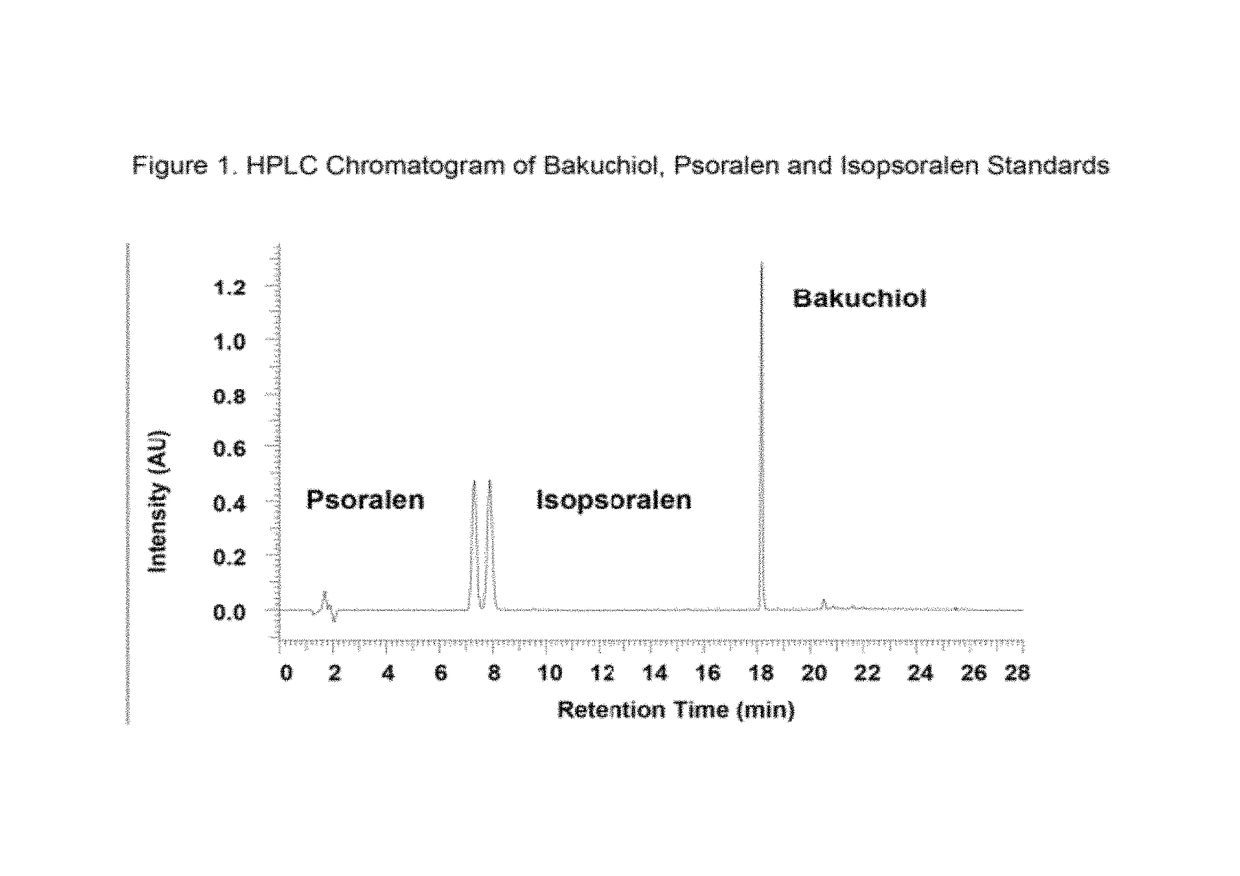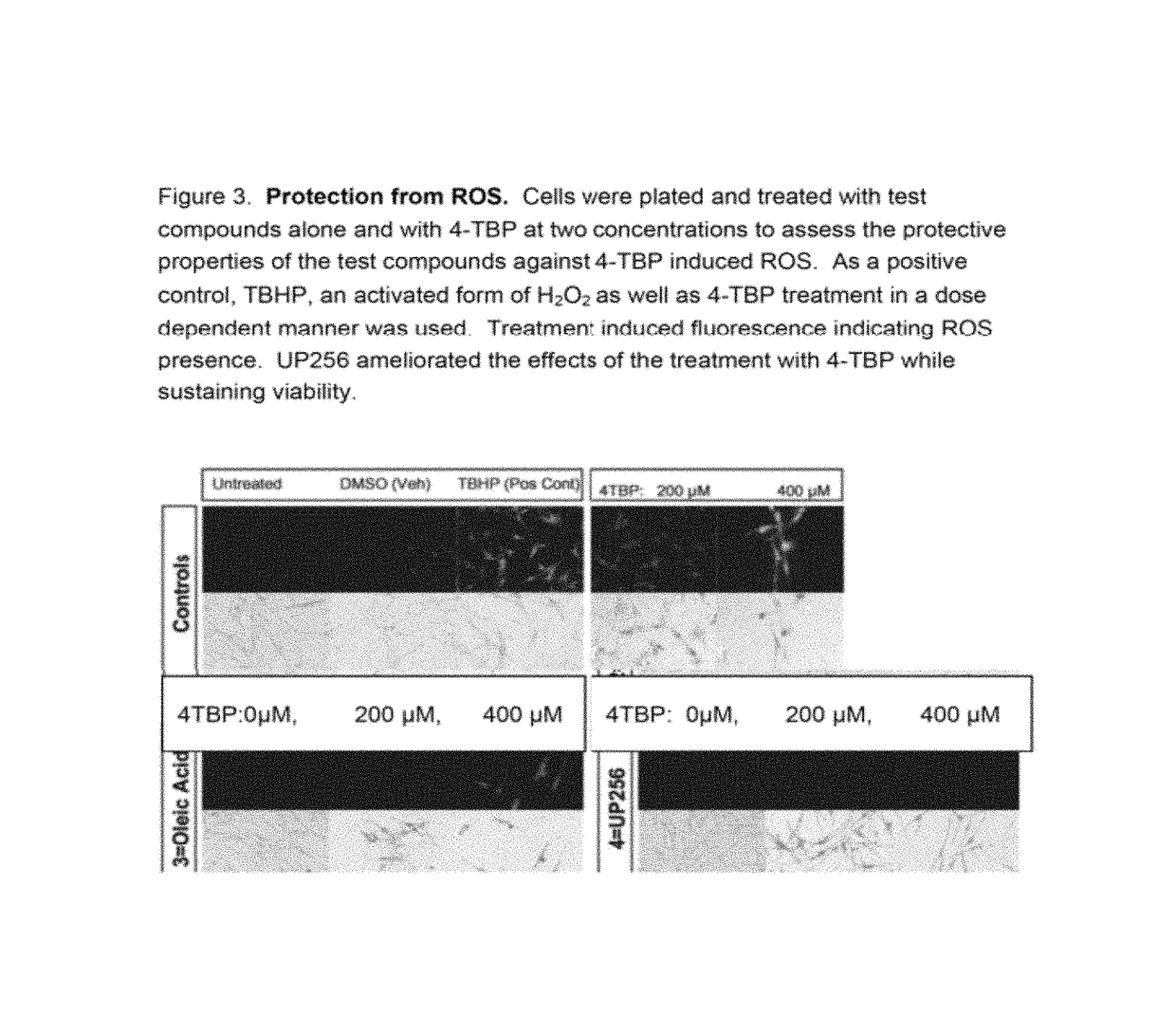Bakuchiol compositions for treatment of post inflammatory hyperpigmentation
a technology of compositions and bakuchiol, applied in the field of bakuchiol compositions, can solve the problems of non-specific discoloration of the regular skin near the pih site, the difficulty of pih treatment with traditional agents, skin whitening agents or tyrosinase inhibitors, etc., and achieve the effects of reducing excess pigmentation, preventing excess pigmentation, and alleviating excess pigmentation
- Summary
- Abstract
- Description
- Claims
- Application Information
AI Technical Summary
Benefits of technology
Problems solved by technology
Method used
Image
Examples
example 1
Quantification of Bakuchiol, Psoralen and Isopsoralen by HPLC
[0122]The amount of bakuchiol, psoralen and isopsoralen in the extracts, fractions, process materials, ingredients and final formulated products were quantified by high pressure liquid chromatography (HPLC) using a PhotoDiode Array detector (HPLC / PDA). The targeted compounds were eluted from a Luna Phenyl-hexyl column (250 mm×4.6 mm) using an acetonitrile (ACN) or methanol & water gradient from 36% to 100% ACN over a period of 12 minutes, followed by 100% ACN for three minutes. The detailed HPLC conditions used are set forth in Table 1. A chromatogram of the HPLC separation is shown in FIG. 1. The targeted compounds were identified and quantified based on retention time and UV peak area using commercially available pure bakuchiol, psoralen and isopsoralen as quantification standards. The retention times for the bakuchiol, psoralen and isopsoralen were 18.19 minutes, 7.33 minutes and 7.95 minutes, respectively.
[0123]
TABLE 1...
example 2
General Methods for Extraction of Bakuchiol from Psoralea Plants
[0124]Method A—To a flask was added solvent (100 mL) and Psoralea corylifolia seed powder (10 g), and the mixture was shaken on a wrist shaker at room temperature for one hour. The mixture was then passed through a filter and the filtrate collected. The extraction process was repeated one more time with fresh solvent, the filtrates were combined, the solvent removed on a rotoevaporator and the residue dried under high vacuum.
[0125]Method B—To a flask was added solvent (50 mL) and Psoralea corylifolia seed powder (10 g), and the mixture was refluxed for 40 min. The solution was then filtered and the extraction process was repeated two more times with fresh solvent. The filtrates were combined, and the solvent was evaporated to obtain a dried extract.
[0126]Following the above extraction methods, sample plant material was extracted with the following solvents: dichloromethane (DCM), ethyl acetate (EtOAc), acetone, methanol...
example 3
Chromatographic Methods for Purifying Bakuchiol Extracts
[0128]Various chromatographic methods were utilized for purifying bakuchiol from the crude solvent extract isolated from the seeds of Psoralea corylifolia using the method described in Example 2. The efficiency of a specific column enrichment method was demonstrated as a means of obtaining high purity bakuchiol free of contamination by furanocoumarins, particularly psoralen / isopsoralen contamination. Briefly, each empty column cartridge (1.3 cm internal diameter (ID) and 20 mL capacity, from Bio-Rad) was packed with a different media and eluted with different solvents in an attempt to separate the furanocoumarin impurities from bakuchiol. The fractions (10 mL per fraction) were collected in test tubes and analyzed with silica gel TLC plates developed with 20% EtOAc / petroleum ether. The targeted compounds, bakuchiol, psoralen and isopsoralen, were identified based on their retention times, which were determined using solutions o...
PUM
| Property | Measurement | Unit |
|---|---|---|
| partition coefficient | aaaaa | aaaaa |
| internal diameter | aaaaa | aaaaa |
| temperature | aaaaa | aaaaa |
Abstract
Description
Claims
Application Information
 Login to View More
Login to View More - R&D
- Intellectual Property
- Life Sciences
- Materials
- Tech Scout
- Unparalleled Data Quality
- Higher Quality Content
- 60% Fewer Hallucinations
Browse by: Latest US Patents, China's latest patents, Technical Efficacy Thesaurus, Application Domain, Technology Topic, Popular Technical Reports.
© 2025 PatSnap. All rights reserved.Legal|Privacy policy|Modern Slavery Act Transparency Statement|Sitemap|About US| Contact US: help@patsnap.com



